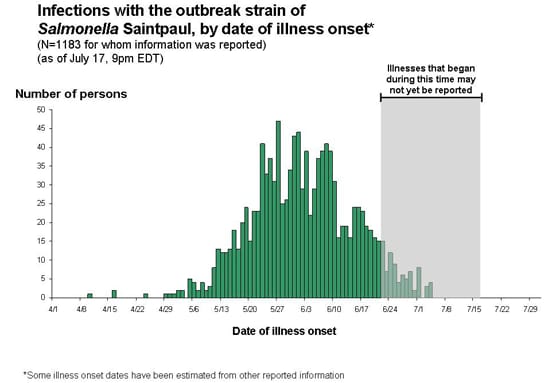The Centers for Disease Control and Prevention have just issued a new report on the ongoing outbreak of Salmonella serotype Saintpaul infection. Since April, 1237 people have been infected. The investigation has continued to focus on raw tomatoes but also jalepeño (and serrano) chiles and cilantro. This further supports my previous speculation, based on the age profile of the cases, that salsa consumed while drinking alcoholic beverages might be implicated in this outbreak. Epidemiological investigations are greatly complicated when multiple vehicles that are typically consumed together are implicated.
There is an interesting caution that accompanies the epidemic curve:

This has to do with the fact that it can be very misleading to read too much into an epidemic curve for an ongoing outbreak. Consider the epidemic curve for the 2003 SARS outbreak in Singapore:

Now imagine we were looking at the curve as it evolved on 12 March. We might have be tempted to say that the epidemic was coming to an end and, man, would we ever have been wrong! There are a couple of things at work here. First, epidemics often have multiple introductions and while theory tells us that an epidemic curve will be more or less bell shaped, this is based on the assumption of a single introduction. If you look at the SARS epidemic curve hard enough, you can see several more-or-less bell-shaped components added together. The second issue with SARS is that there is extreme heterogeneity in transmission. Patient #1 probably infected 21 other cases, patient #4 probably infected 62. The great majority of others infected none. Individuals who infect more than 10 others are what is known as "superspreaders." There were five in the Singapore outbreak out of a total of 201 probable cases of SARS and 722 suspect cases. Finally, there is often a delay between when people get sick and when their cases are reported. This means that the trailing edge of the epidemic curve always looks like it's closing off its bell shape. The full case report for the Singapore outbreak can be found here.
So, is the current Salmonellosis outbreak on the wane? Let's hope so, but as CDC warns:
It can be difficult to say when the outbreak is over, because of the reporting delay. The delay means that the curve for the most recent three weeks always looks like the outbreak could be ending even during an active outbreak. The full shape of the curve is only clear after the outbreak is over.
With a vehicle-borne disease, we don't have to worry about superspreaders, but the fact that we still don't know the source of the infection or the ultimate cause of the contamination is troubling. Who knows how much contaminated (presumably) produce is lurking out there? I, for one, will make sure to wash my produce well!

